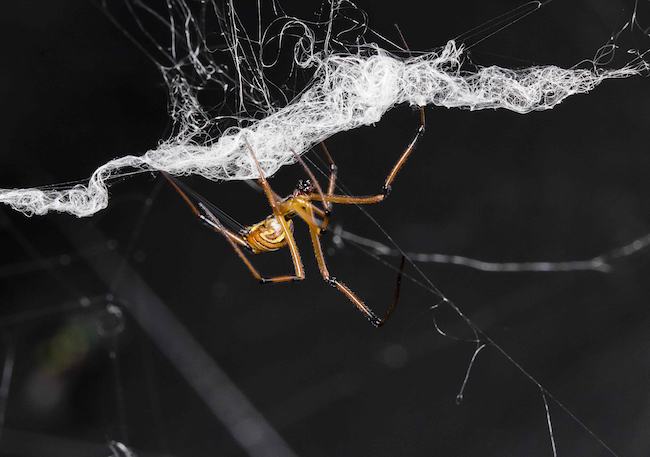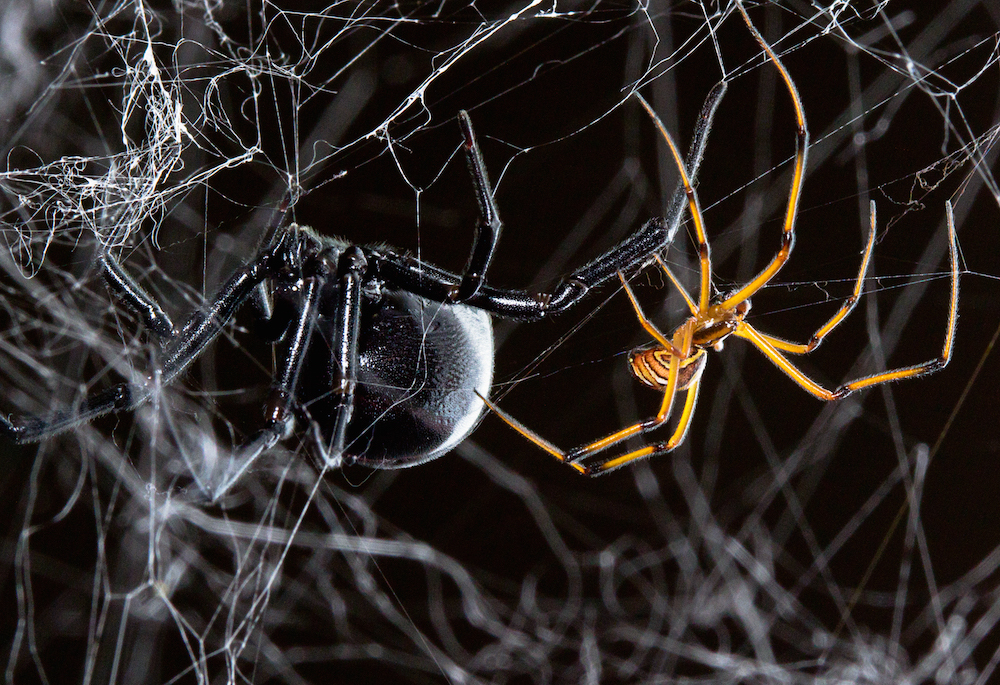Black Widows Wreck Mates' Webs, Get Away With It

Picture this: You go on a few dates with a guy and then, one day, he comes over and starts demolishing your home. If you were a human female, you'd probably break things off. But you might feel differently about your boyfriend's destructive behavior if you were a female black widow spider, a new study suggests.
Researchers found that black widow males destroy large sections of their mates' webs in order to ward off potential rivals. Then, they do something even weirder; they bundle up the part of the web they destroyed and cover it with their own sticky silk. And female black widows don't do anything to stop their mates' home-wrecking behavior, according to the study by researchers at Simon Fraser University in Canada.
Why would a spider as infamous (and venomous) as a black widow let a mate tear her web apart? Well, it's pretty simple, the researchers said. The female spiders might be so preoccupied getting busy with the males they like best, they can't keep all their pesky suitors at bay. As such, they may be letting their partners fight off other males for them. For male black widows, torn up nests are a turn-off and can keep the males from coming too close to potential mates, the study found. [Creepy, Crawly & Incredible: Photos of Spiders]
Spider sex

The researchers studied the western black widow spider (Latrodectus Hesperus), which inhabits western regions of North America. While this spider's name implies a grizzly tendency to follow up sex with murder, western black widow females do not usually eat their mates after they copulate (unless they're starving), said Catherine Scott, an arachnologist at Simon Fraser University and lead researcher of the study.
And while lots of humans live in fear of a black widow's allegedly "deadly" bite, the truth is that black widow bites don't normally kill people, Scott told Live Science in May. Most people who are bitten by one of these spiders recover on their own or are healed with medical intervention, she said.
Black widows build webs that do more than just help them catch supper. A black widow's silky web is covered with the spider's pheromones, chemical secretions that may serve as aphrodisiacs to members of the opposite sex. Thus, the web also serves as a kind of billboard that gives passersby more information about its occupant.
Sign up for the Live Science daily newsletter now
Get the world’s most fascinating discoveries delivered straight to your inbox.
"The silk pheromones that female black widows produce are like scent-based personal ads," Scott said in a statement. "One whiff of the pheromone can tell a male about the age, mating history and even hunger level of the female. These complex chemical messages are just one part of the spiders' communication system.
Come on over
To see how males interact with females' webs, Scott and her fellow researchers let black widow females spin their webs inside laboratory cages for a week. Then, the researchers removed the spiders from their webs and took the web-filled cages to Vancouver Island, a native habitat of western black widows.

The researchers observed wild male black widows as the arachnids interacted with three different kinds of webs: one cage of intact webs, one full of webs in which the silk had been cut up and then bundled together by male spiders, and one in which the silk had been cut up by the researchers and then removed. Scott and her team included the last group to explore potential reasons why male black widows leave strange bundles of silk on the torn up webs of their mates.
Six hours after the cages were placed in the wild, the webs that were left intact had attracted 76 males. The webs the researchers had cut up themselves were also attractive to male black widows, with almost as many males stopping by as with the webs that were left intact (53 males within the first six hours of the experiment). The webs that got the least amount of attention were those that had previously been cut up and bundled by other males (only 21 males checked out this cage in six hours).
So male black widows are just as attracted to intact webs as they are to webs cut up by researchers. By contrast, they're not very attracted to webs that are cut up and bundled together by other male spiders. This finding implies that whatever those home-wrecking spiders are doing when they cut and bundle their mates' webs is helping keep other male spiders away, according to Scott.
"One possibility is that the female pheromone is concentrated in certain areas of the web, and males are bundling up those specific sections with silk, which stops the pheromone from being released," Scott said. "The males could also be adding their own pheromones, which rival males avoid. We didn't find evidence for a male silk pheromone in these experiments, but it's definitely something we want to investigate further."
But however the males are keeping other rivals away, their mates certainly don't seem to mind. Female black widows tend to remain passive, even when their webs are being actively destroyed, the researchers found. This is likely because a smaller web that spews out fewer pheromones is advantageous to a recently wooed female, said Scott, who noted that, by messing with females' webs, male spiders are really interfering with the message that web relays to other males.
"Courtship in black widows is an hours-long affair, so several additional males may arrive at a web before the first male manages to copulate," Scott said. "By reducing the web, the male is not only reducing his chances of competing with other males, [but] he might also be doing the female a favor. Web reduction may be giving her the opportunity to rebuild her web without pheromones and get on with reproduction, rather than wasting time and energy chasing away a parade of redundant male suitors."
The researchers published their findings in the July 13 edition of the journal Animal Behaviour.
Follow Elizabeth Palermo @techEpalermo. Follow Live Science @livescience, Facebook & Google+. Original article on Live Science.

Elizabeth is a former Live Science associate editor and current director of audience development at the Chamber of Commerce. She graduated with a bachelor of arts degree from George Washington University. Elizabeth has traveled throughout the Americas, studying political systems and indigenous cultures and teaching English to students of all ages.









